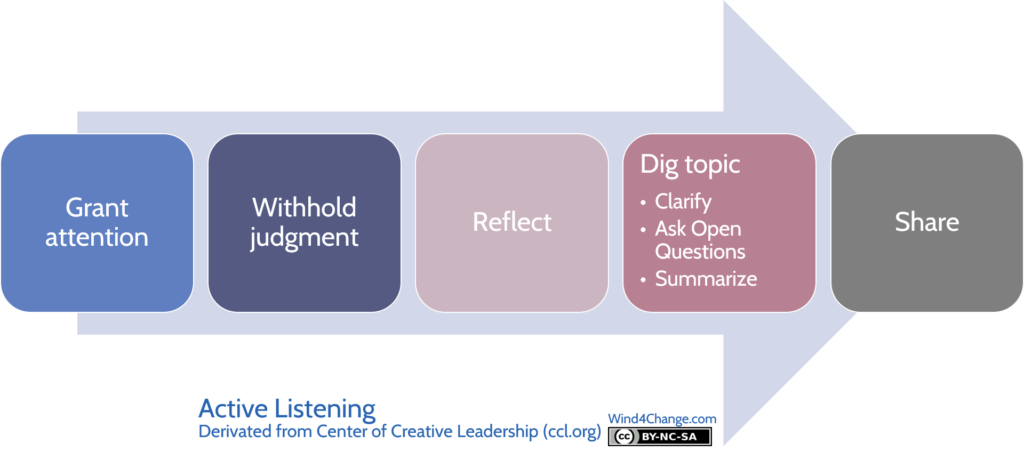Building trust, performing actively listening and delivering a good and constructive feedback are the 3 core tools of the coaching for me. Furthermore, other expression for active listening are effective or attentive listening.
- The trust equation from David Maister: building the trust relationship
- Active listening: attentive and effective listening
- Delivering constructive feedback
- What's next? Learn more about Coaching and discover Change Management
- Do you want to learn more about trust, feedback and active listening in Coaching? Here are some valuable references
The trust equation from David Maister: building the trust relationship
The first step of all is to build the relationship with the coachee. Indeed, this is required even just for the coachee to be open to the feedback of the coach.

To illustrate, the elements needed to build trust can be collected in an equation as invented by David Maister, the Trust Equation:
- Firstly, at the numerator are items supporting the trust:
- Credibility: does coach know what he/she is talking about? Really, the coach should demonstrate expertise in his/her field.
- Reliability: does the coach meet his/her promises? Truly, repeated failures to do what you say you are going to do undermines trust. In addition, it is also true with small things like being on time at meetings.
- Intimacy: how close the coach gets to the coachee for him/her feel comfortable to disclose confidential information.
- Secondly, at the denominator is an item spoiling the trust: personal agenda. Indeed, does the coach has the coachee’s best interests at heart or is he/she helping to get something out of it?
Active listening: attentive and effective listening

Active listening meaning, definition, is listening to understand not just to answer, with calm, kindness and genuine curiosity. Beside that, it relies on a couple of skills and techniques:
- Firstly, grant attention:
- Make the person comfortable by your tone and body language.
- Demonstrate attention with your body language: nod, make eye contact, and lean forward.
- Do not cut the person.
- Allow pauses.
- Be focused on the moment.
- Secondly, withhold your judgment: even if you have a strong view on on the topic, be open-minded to new or even just different ideas, perspectives or options.
- Thirdly, reflect with the person:
- Receive the person emotions and align your body language.
- Paraphrase key points and use verbal affirmations to demonstrate attention like “I see”, “I understand”.
- Fourthly, dig the topic:
- Clarify: ask specific questions to seek clarification whenever you have doubt or it is unclear to you.
- Ask open-ended questions to facilitate the exploration.
- Summarize: restate key themes as the conversation goes to confirm and consolidate your understanding of the other person’s point of view.
- At last, share: active listening is first about understanding the other person, then about being understood. Once you have understood the person:
- To start, you can introduce your ideas, feelings, and suggestions.
- Then, you might talk about a similar experience you had or share ideas triggered by the conversation.
- To finish, you can switch with the person to investigating potential solutions.
Delivering constructive feedback
“Feedback is a gift”, some of them are gift you just want to sell back quickly on eBay. First as seen above, the coach needs to prepare the coachee to be open to his/her feedback to properly receive it and be able to use it. Definitively, a trust relationship is the prerequisite. Then there is a good way to deliver the feedback to maximize benefits for the coachee.
What are the characteristics of a good and constructive feedback ?
- Firstly how it is delivered:
- With empathy,
- With honesty,
- Just after the facts,
- With proactive language,
- Face-to-face of course!
- Secondly, what is delivered with the feedback, what is the meaning of feedback:
- A clear and direct message,
- Observed facts and behaviors that should be expressed as such,
- Relevant and actionable suggestion(s) that should be formulate as a proposal (“you could” is better than “you should”).
What is the process and how to deliver a good and constructive feedback?

- Firstly, the observation of facts,
- Secondly, the effect on the person providing the feedback or perceived outcome,
- Then, a pause to listen the person receiving the feedback and answering the questions for clarification,
- At last, a suggestion of improvement proposed to the person receiving the feedback. Here also there is a time for the person to react on the suggestion.
These 3 core tools are the basis to deliver effective coaching, at team or enterprise level, and support change management in agile or other fields.
What’s next? Learn more about Coaching and discover Change Management
Read my other posts on coaching for instance on the Coaching Competencies, on the GROW Model and the Powerful questions, on the delegated roles in meeting and on Change Management.
Do you want to learn more about trust, feedback and active listening in Coaching? Here are some valuable references
- The equation of Trust from the book The Trusted Advisor written by David Maister and the website of the author.
- A good post about Active Listening.
- A post about the essential on feedback.
